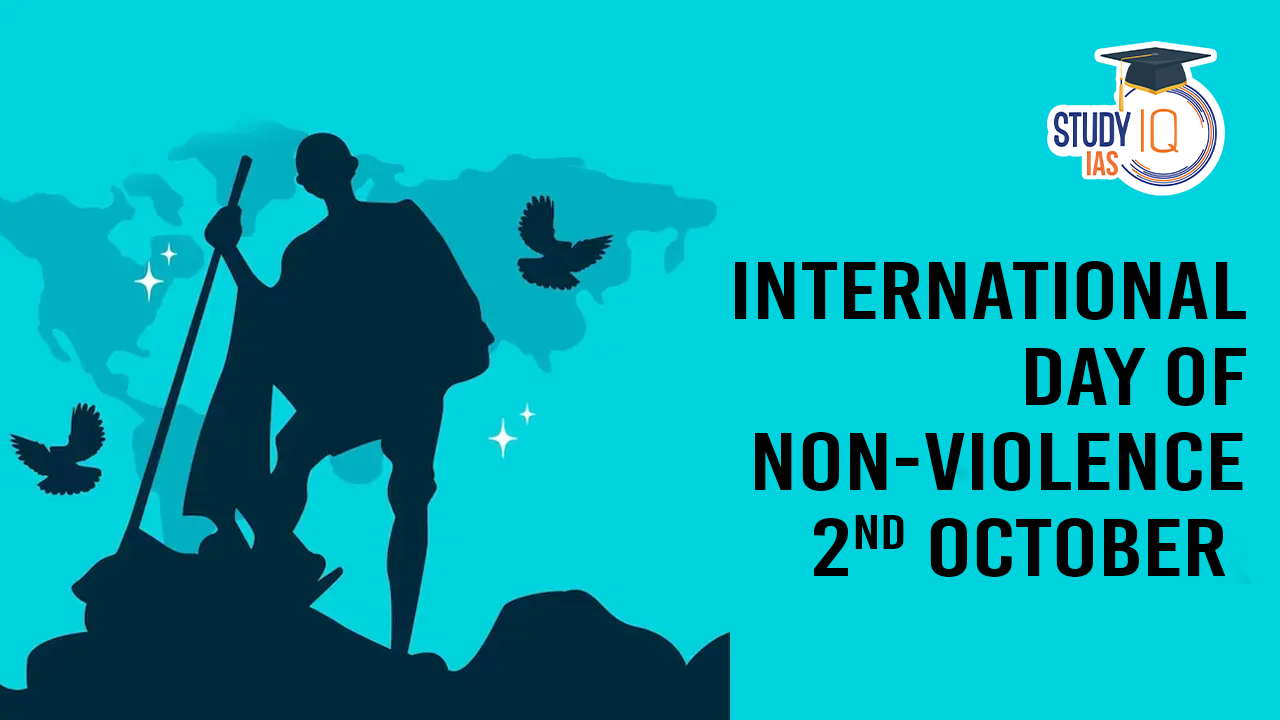Table of Contents
International Day of Non-Violence 2024
The International Day of Non-Violence is observed annually on October 2nd by the United Nations, in honour of Mahatma Gandhi, the leader of India’s independence movement and a visionary of non-violent resistance. Established through United Nations General Assembly resolution A/RES/61/271 on June 15, 2007, this day promotes Gandhi’s philosophy of peace and non-violence, with the support of 140 co-sponsors.
Mahatma Gandhi Jayanti, on October 2nd, was chosen to celebrate this day, highlighting his unwavering commitment to non-violence. As we commemorate the International Day of Non-Violence, we reflect on the significance of this occasion and Gandhi’s timeless message of non-violence, which continues to inspire people worldwide. In this article, we will look into the history and importance of the International Day of Non-Violence 2024.
Gandhi Jayanti 2024
Gandhi Jayanti 2024 is celebrated on October 2nd, marking the 155th birth anniversary of Mahatma Gandhi. This national holiday in India commemorates the life and legacy of Mahatma Gandhi, the Father of the Nation, who led India’s non-violent struggle for independence from British rule.
Gandhi Jayanti is not only a tribute to Gandhi’s efforts toward India’s freedom but also to his enduring philosophy of non-violence (Ahimsa) and truth (Satyagraha). Gandhi’s ideas have inspired global movements for civil rights and freedom, making him an iconic figure for peace worldwide.
International Day of Non-Violence Theme 2024
The theme for the International Day of Non-Violence 2024 focuses on “Fostering Global Peace through Cultural and Educational Exchanges”. This theme emphasizes the importance of promoting non-violence through education, awareness, and cultural collaboration to build a more peaceful and understanding world. The day, observed annually on October 2nd in honour of Mahatma Gandhi, highlights the power of peaceful solutions to conflicts and the role of dialogue in fostering harmony.
History of International Day of Non-Violence
The International Day of Non-Violence was established by the United Nations General Assembly on June 15, 2007, through the resolution A/RES/61/271. It is observed annually on October 2nd, coinciding with the birth anniversary of Mahatma Gandhi, the leader of India’s independence movement and a global icon of non-violent resistance.
This day was created to promote the principles of non-violence and to honour Gandhi’s legacy of advocating for peaceful solutions to conflicts. The resolution that established the day had strong international support, with 140 co-sponsoring countries. The core objective of the day is to promote awareness of non-violence through education and public consciousness.
The United Nations uses this day to reaffirm the relevance of Gandhi’s philosophy, which emphasized that non-violence is a powerful force for social change and a key strategy in achieving peace, justice, and freedom. It also encourages individuals and governments to seek non-violent solutions to conflicts in order to foster a more peaceful world.
Objectives of International Day of Non-Violence
The objectives of the International Day of Non-Violence include:
- Promoting Non-Violence: To foster a culture of peace and non-violence through education, public awareness, and collective efforts.
- Honoring Mahatma Gandhi’s Legacy: Celebrating Gandhi’s birthday and recognizing his contributions to non-violent movements across the world.
- Global Awareness: Encouraging nations, communities, and individuals to embrace peaceful means of conflict resolution and social change.
- Encouraging Peaceful Coexistence: Advocating for peaceful dialogue over violence to address global issues such as political conflicts, inequality, and discrimination.
- Inspiring Social Justice Movements: To promote the universal relevance of non-violent resistance in achieving social and political justice.
Why is Gandhi Jayanti Celebrated on 2nd October?
Gandhiji and Struggle for Non-Violence Philosophy
Mahatma Gandhi’s struggle for the philosophy of non-violence was grounded in the belief that non-violent resistance was the most powerful means of achieving social and political change. While Gandhi didn’t create the concept of non-violence, he significantly elevated it, turning it into a central tenet for large-scale movements for justice, particularly during India’s independence struggle.
Forms of Violence
Gandhi identified two main forms of violence:
- Passive Violence: Actions or attitudes that contribute to harm without physical confrontation, such as discrimination or social injustice.
- Physical Violence: Direct physical harm.
He emphasized that passive violence often leads to physical violence, and breaking this cycle was essential. Gandhi believed that non-violence (Ahimsa) was not just the absence of violence but an active force of love and understanding that requires self-discipline and moral courage.
Non-Violence as Courage
For Gandhi, true non-violence involved the acceptance of suffering rather than inflicting harm on others. He rejected the idea that non-violence was an act of weakness; instead, he saw it as an act of profound bravery. This led to the development of Satyagraha—a method of non-violent resistance. Satyagraha combined:
- Truth (Satya): Pursuit of absolute truth and moral righteousness.
- Firmness (Agraha): Determination to resist oppression non-violently.
| Examples of Satyagraha | |
| Champaran Satyagraha | Kheda Satyagraha |
| Individual Satyagraha | Bardoli Satyagraha |
Truth and Non-Violence
To Gandhi, truth and non-violence were inseparable. He famously declared, “Truth is God,” expressing the idea that truth was an eternal force that could never be destroyed. His commitment to truth formed the foundation of his Satyagraha movements, where non-violence was used as a strategic and moral weapon to expose the injustice of colonial rule.
Power of Non-Violence
Gandhi believed in the transformative power of non-violence as a tool to address social disintegration. He argued that violence was learned behavior, and non-violence was a powerful antidote to it. His stance on non-violence was grounded in the idea that “just means lead to just ends.”
Satyagraha: The Essence of Non-Violence
Gandhi’s concept of Satyagraha was not just passive resistance but an active form of non-violent action. This philosophy guided many civil rights movements worldwide. Key aspects of Satyagraha include:
- Civil Disobedience: Peaceful defiance of unjust laws (e.g., Gandhi’s Dandi March of 1930).
- Non-Cooperation: Withdrawing from systems of oppression.
- Self-Suffering: Enduring hardships without retaliating against opponents, to highlight moral superiority.
Through Satyagraha, Gandhi sought to change hearts, believing that love and patient suffering could win over even the most oppressive rulers.
Legacy and Global Impact
Gandhi’s philosophy of non-violence deeply influenced global leaders like Martin Luther King Jr. and Nelson Mandela, inspiring movements for justice, civil rights, and freedom across the world. His unwavering commitment to non-violence, even in the face of violence and oppression, remains a cornerstone of peaceful resistance movements today.


 Topological Materials: The Future of Qua...
Topological Materials: The Future of Qua...
 China’s Deep Sea Station in South Chin...
China’s Deep Sea Station in South Chin...
 Project ICE-CRUNCH: India-Switzerland Co...
Project ICE-CRUNCH: India-Switzerland Co...





















